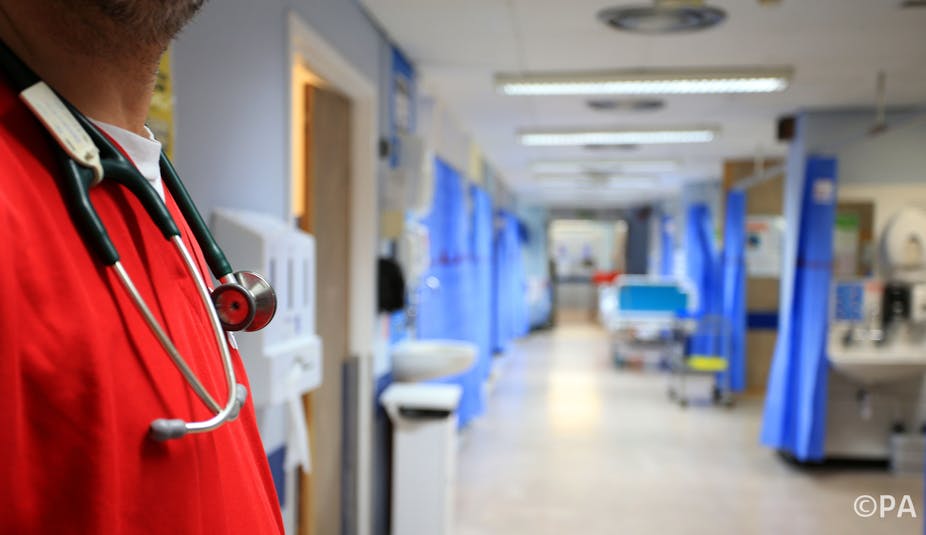We got rid of 20,000 bureaucrats in the NHS and put that money into 9,000 more doctors and 7,000 more nurses.
David Cameron, Conservative leader, during an interview on Channel 4/Sky News.
The National Health Service is the single largest employer in the England, accounting for one out of 18 in the workforce. It’s not surprising then that Labour leader Ed Miliband and Conservative leader David Cameron have come to verbal blows about the size and composition of the NHS workforce.
In response to Miliband’s accusation in the last prime minister’s questions before the election that the coalition had broken its promise not to engage in a top-down reorganisation of the NHS, Cameron replied that “there are 9,000 more doctors, 7,000 more nurses, and 20,000 more (sic) bureaucrats” now working in the NHS than when the coalition came to power. The Conservative Party has since confirmed that Cameron meant to say “fewer” bureaucrats, a claim which he went on to repeat in a live interview debate programme hosted by Jeremy Paxman a day later.
Are Cameron’s claim about NHS staff numbers substantiated by the evidence? The overall number staff – measured as full time equivalents – working for the NHS has changed little over the term of the coalition, increasing by 1.2% from 1,173,248 in May 2010 to 1,187,606 in December 2014, for which the latest figures for the NHS Workforce Statistics were made available on March 25 2015.

While the overall numbers of staff have not increased substantially, there have been marked changes in the composition of staff. The coalition has placed great store on reducing the costs of NHS administration. Indeed the number of “bureaucrats” has actually fallen by almost 20,000 – there being 6,700 fewer managers and 12,900 fewer support staff in December 2014 compared to May 2010. Managers now account for just 3% of the NHS workforce, a much lower proportion than the 15% in the workforce generally.
The coalition promised to devote more resources to “front-line” staff, namely doctors and nurses. There has been a large increase in the number of hospital doctors, up 5,600 (16%) from 35,000 in May 2010 to 41,000 in December 2014. The number of GPs has also risen, but less markedly so, by 5%, to 37,000 in December 2014.
Even so, GPs have been complaining that this is insufficient to meet increased demand, fueled by growth in an increasingly elderly population of upwards of 0.6% per year. Together, there are 7,293 more hospital doctors and GPs in December 2014 than there were in 2010 – not 9,000 more.
Different story for nurses
Nurses, including midwives and health visitors, comprise the largest group of NHS staff, but their numbers have risen by only 6,400 (2%), from 311,000 in May 2010 to 317,000 in December 2014. Unlike the steady increase in the number of doctors, the number of nurses working in the NHS actually fell in the first years of the coalition government, reaching a low of 304,566 in August 2012.
The number of nurses increased only after publication of the Francis report in 2013 that stated that inadequate staffing levels had led to poor quality care at Mid Staffordshire.
Changes in the size and composition of the NHS workforce have occurred over a period in which ever-increasing numbers of people have been treated by the NHS. The widening gap between demand and supply means that staff have been working harder, contributing to improvements in NHS productivity. This is probably unsustainable going forward, and the workforce will need to increase further to meet future demands, which is why there have been promises by all the main political parties to increase spending on the NHS.
Verdict
In summary, the coalition has changed the composition of the NHS workforce, getting rid of almost 20,000 managers and support staff. But Cameron has over-claimed the increase in front-line staff: the number of doctors has increased by 7,293 not 9,000 and the number of nurses by 6,434, not 7,000.
Review
Health care is labour intensive. Claiming growth in the number of NHS staff is a common tactic of pre-election incumbent governments. It makes a headline, but analysis has to check if there are sufficient staff, and if they are working in the “right” place.
The analysis above is accurate, but also correct to add caveats. NHS staffing growth since May 2010 is patchy and uneven. Primary care, the focus of population health priorities, has lagged. There has been an actual fall in the number of nurses working in community services, including a drop of 2,000 district nurses. GP growth has not tracked hospital doctor growth.
Health Education England, responsible for NHS workforce planning, noted in its 2015-16 plan that “nursing in the acute sector may grow at the community’s expense”. It also reported that NHS trusts are currently reporting a vacancy rate of 6.5% in nursing. “More” staff may not be enough staff, or the right staff. – James Buchan
Click here to request a check. Please include the statement you would like us to check, the date it was made, and a link if possible. You can also email factcheck@theconversation.com

